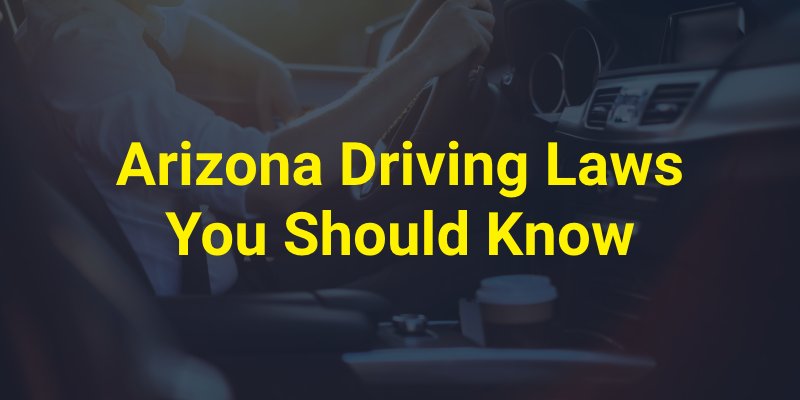Being behind the wheel requires a certain level of responsibility. It’s not just about having control of your vehicle and knowing how to drive safely, but also understanding and adhering to the necessary laws that rule the road. If you’re driving in Arizona, respecting local traffic regulations is essential for both your safety and legal liability concerns.
Below, our Phoenix car accident attorneys share some of the most important Arizona driving laws you should be aware of.

Arizona’s Move Over Law seeks to provide emergency vehicles with a necessary buffer zone on highways. If you are approaching any vehicle with flashing lights parked by the side of a road or highway, you are mandated by law to change lanes, moving away from the stationary vehicle.
If this isn’t possible because you can’t change lanes safely or there isn’t another lane to move into, you must slow your speed.
“If a person who drives a vehicle approaches a stationary vehicle and the stationary vehicle is giving a signal by displaying alternately flashing lights or is displaying warning lights, the person shall do either of the following:
In an attempt to discourage problematic driving during adverse weather conditions, Arizona’s Stupid Motorist Law takes a strong stance against motorists who ignore flood warnings. If you drive past clearly marked signs or barricades and proceed into flooded areas, you put yourself in potential legal trouble.
Under this law, if your vehicle is stranded and requires rescue services as a result of such actions, you will be personally held financially responsible for the cost of those services.
“A driver of a vehicle who drives the vehicle on a public street or highway that is temporarily covered by a rise in water level, including groundwater or overflow of water, and that is barricaded because of flooding is liable for the expenses of any emergency response that is required to remove from the public street or highway the driver or any passenger in the vehicle that becomes inoperable on the public street or highway or the vehicle that becomes inoperable on the public street or highway, or both…”
The underlying goal is to ensure safety and incentivize smart decision-making by implementing consequences for risky and unnecessary behavior.
Arizona’s Hands Off Law promotes safer driving by addressing the dangers of distracted driving due to electronic devices. Texting and talking on these devices (unless used in hands-free mode), including having them propped between your head and shoulder, is against the law.
The law also extends beyond communication; things like browsing the internet, watching videos, or even recording something while you’re behind a wheel can land you into legal trouble.
“Unless a motor vehicle is parked or stopped pursuant to section 28-645, subsection A, paragraph 3 or section 28-851, a person may not operate a motor vehicle on a street or highway if the person does either of the following:
(a) A portable wireless communication device, except that a person may use a portable wireless communication device with an earpiece, headphone device or device worn on a wrist to conduct a voice-based communication.
(b) A stand-alone electronic device.
Upholding the principle of safety first, Arizona seat belt laws require every passenger in the front seat of a vehicle to be properly secured using a seat belt. As a driver, you are specifically responsible for ensuring that passengers under 16 years old are wearing their seatbelt no matter where they are seated in the vehicle.
“Each front seat occupant of a motor vehicle that is designed for carrying ten or fewer passengers, that is manufactured for the model year 1972 and thereafter and that is required to be equipped with an integrated lap and shoulder belt or a lap belt pursuant to the federal motor vehicle safety standards prescribed in 49 Code of Federal Regulations section 571.208 shall either:
B. The operator of a motor vehicle that is designed for carrying ten or fewer passengers, that is manufactured for the model year 1972 and thereafter and that is required to be equipped with an integrated lap and shoulder belt or a lap belt pursuant to the federal motor vehicle safety standards prescribed in 49 Code of Federal Regulations section 571.208 shall require each passenger under sixteen years of age to either:
In Arizona’s intense heat, being inside a vehicle without air conditioning or effective air flow is not merely uncomfortable – it can be deadly for pets and small children who don’t’ have the ability to let themselves out.
Acknowledging this dangerous situation led authorities to implement what is popularly known as Arizona’s Good Samaritan law in 2017.
It allows you as a bystander to take decisive action if you identify an unattended animal or child in a vehicle believed to be at risk of overheating: it gives you permission to break into the vehicle with the aim of removing those trapped inside.
The statute also grants you immunity against any civil liability that might normally arise due to property damage in such a situation.
Understanding Arizona’s driving laws is crucial, whether you’re dealing with a simple parking ticket or an unfortunate traffic incident. However, these issues can sometimes be complex to navigate without assistance. If you have questions or need help, don’t hesitate to contact us to schedule a free consultation.